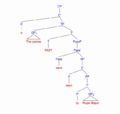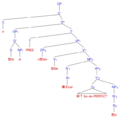Voice (grammar) facts for kids
Voice in grammar expresses the way the action (or state) that the verb expresses relates to the subject or object. In English grammar, there are two voices: active and passive. When a clause is in the active voice, the subject is the doer of the action. When a clause is in the passive voice, the subject is the receiver of the action. The active voice is much more commonly used than the passive voice.
- Active voice: Jane chose the furniture.
- Passive voice: The furniture was chosen by Jane.
Contents
The Passive Voice
Forming the Passive Voice
In passive clauses, the object is moved to the subject position. Generally, only transitive verbs can be transformed into the passive voice, because only transitive verbs have with objects. Verbs in the passive voice are formed using the past participle of the main verb with the auxiliary verb conjugated into the appropriate tense.
Reasons for using the Passive Voice
The passive voice changes the focus from the doer (or agent) of the action onto the receiver of the action. There are many reasons to do this. Sometimes we don't know who the agent is:
- The store was robbed last night.
- A package was left on the steps.
Sometimes the receiver is more important than the agent:
- Julio was hit by a car.
- The robber was arrested this evening.
Images for kids
See also
 In Spanish: Voz gramatical para niños
In Spanish: Voz gramatical para niños















